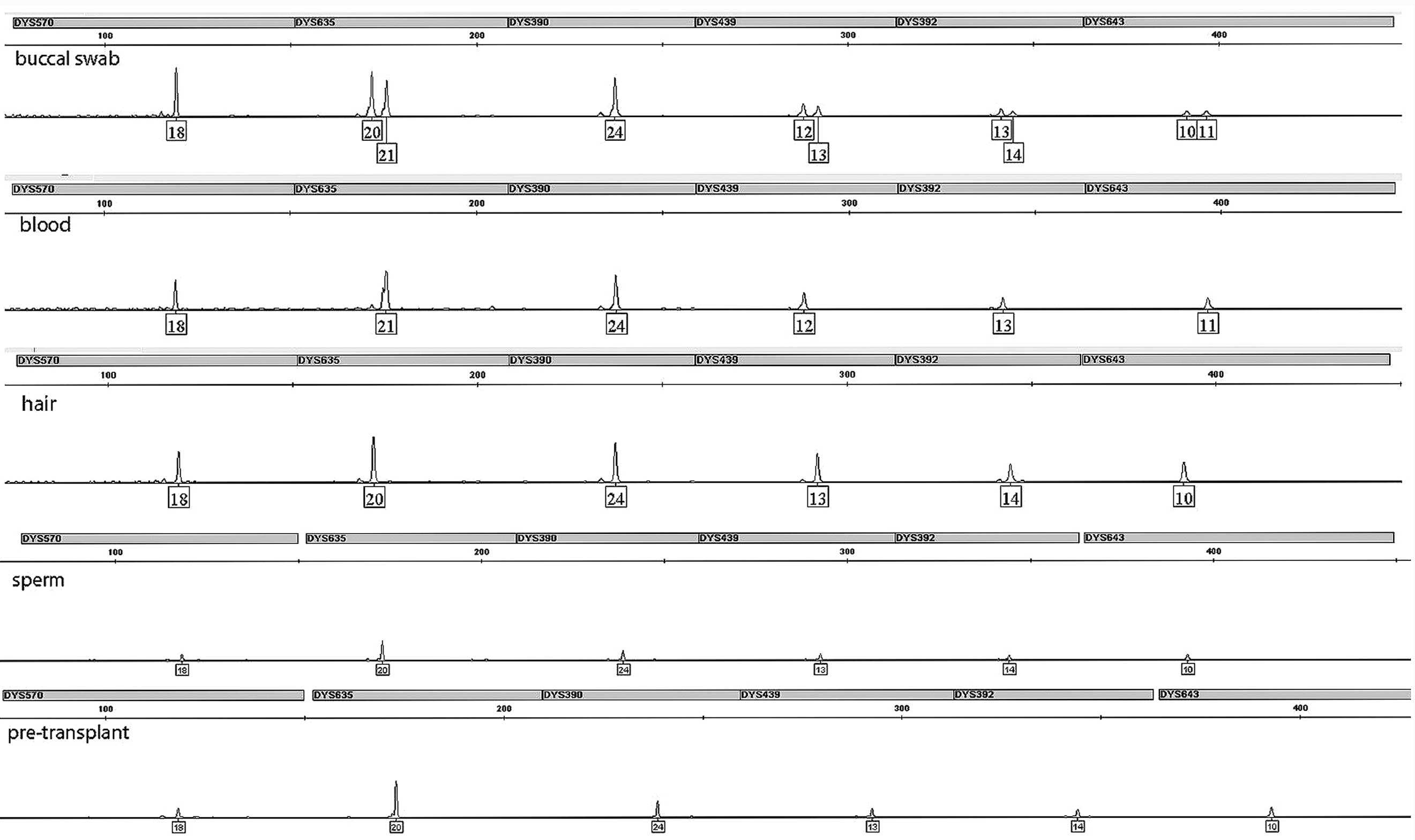|
1
|
Hardy RE and Ikpeazu EV: Bone marrow
transplantation: a review. J Natl Med Assoc. 81:518–523. 1989.
|
|
2
|
Theise ND, Badve S, Saxena R, et al:
Derivation of hepatocytes from bone marrow cells in mice after
radiation-induced myeloablation. Hepatology. 31:235–240. 2000.
View Article : Google Scholar : PubMed/NCBI
|
|
3
|
Krause DS, Theise ND, Collector MI, et al:
Multi-organ, multi-lineage engraftment by a single bone
marrow-derived stem cell. Cell. 105:369–377. 2001. View Article : Google Scholar : PubMed/NCBI
|
|
4
|
Mezey E, Chandross KJ, Harta G, Maki RA
and McKercher SR: Turning blood into brain: cells bearing neuronal
antigens generated in vivo from bone marrow. Science.
290:1779–1782. 2000. View Article : Google Scholar : PubMed/NCBI
|
|
5
|
Zhou Y, Li S, Zhou J, et al: DNA profiling
in blood, buccal swabs and hair follicles of patients after
allogeneic peripheral blood stem cells transplantation. Leg Med
(Tokyo). 13:47–51. 2011. View Article : Google Scholar : PubMed/NCBI
|
|
6
|
Tran SD, Pillemer SR, Dutra A, et al:
Differentiation of human bone marrow-derived cells into buccal
epithelial cells in vivo: a molecular analytical study. Lancet.
361:1084–1088. 2003. View Article : Google Scholar : PubMed/NCBI
|
|
7
|
Walsh PS, Metzger DA and Higushi R: Chelex
100 as a medium for simple extraction of DNA for PCR-based typing
from forensic material. BioTechniques. 10(4): 506–13.
April;1991.
Biotechniques. 54:134–139. 2013.
|
|
8
|
Zou KN, Cao Y, Xia ZF, Zheng WG and Zhou
HG: Forensic application of expressmarker 22 STR loci direct PCR
amplification kit. Fa Yi Xue Za Zhi. 28:448–450. 2012.(In
Chinese).
|
|
9
|
Davis C, Ge J, Sprecher C, et al:
Prototype PowerPlex® Y23 System: a concordance study.
Forensic Sci Int Genet. 7:204–208. 2013.
|
|
10
|
Bond JW and Hammond C: The value of DNA
material recovered from crime scenes. J Forensic Sci. 53:797–801.
2008. View Article : Google Scholar : PubMed/NCBI
|
|
11
|
Jacewicz R, Lewandowski K, Rupa-Matysek J,
Jedrzejczyk M, Komarnicki M and Berent J: Genetic investigation of
biological materials from patients after stem cell transplantation
based on autosomal as well as Y-chromosomal markers. Int J Legal
Med. 127:359–362. 2013. View Article : Google Scholar : PubMed/NCBI
|
|
12
|
Hong YC, Liu HM, Chen PS, et al: Hair
follicle: a reliable source of recipient origin after allogeneic
hematopoietic stem cell transplantation. Bone Marrow Transplant.
40:871–874. 2007.PubMed/NCBI
|
|
13
|
Jacewicz R, Lewandowski K, Rupa-Matysek J,
et al: Donor-derived DNA in hair follicles of recipients after
allogeneic hematopoietic stem cell transplantation. Bone Marrow
Transplant. 45:1638–1644. 2010. View Article : Google Scholar : PubMed/NCBI
|
|
14
|
Imanishi D, Miyazaki Y, Yamasaki R, et al:
Donor-derived DNA in fingernails among recipients of allogeneic
hematopoietic stem-cell transplants. Blood. 110:2231–2234. 2007.
View Article : Google Scholar : PubMed/NCBI
|
|
15
|
Brinster RL and Zimmermann JW:
Spermatogenesis following male germ-cell transplantation. Proc Natl
Acad Sci USA. 91:11298–11302. 1994. View Article : Google Scholar : PubMed/NCBI
|
|
16
|
Nollet F, Billiet J, Selleslag D and Criel
A: Standardisation of multiplex fluorescent short tandem repeat
analysis for chimerism testing. Bone Marrow Transplant. 28:511–518.
2001. View Article : Google Scholar : PubMed/NCBI
|
|
17
|
Mayntz-Press KA and Ballantyne J:
Performance characteristics of commercial Y-STR multiplex systems.
J Forensic Sci. 52:1025–1034. 2007. View Article : Google Scholar : PubMed/NCBI
|
|
18
|
Cerri N, Ricci U, Sani I, Verzeletti A and
De Ferrari F: Mixed stains from sexual assault cases: autosomal or
Y-chromosome short tandem repeats? Croat Med J. 44:289–292.
2003.PubMed/NCBI
|











